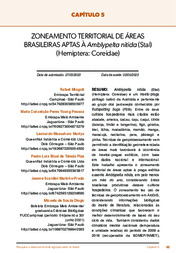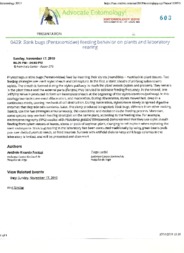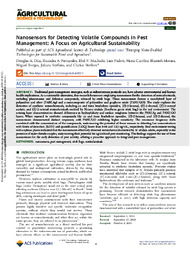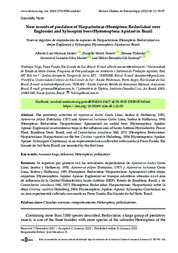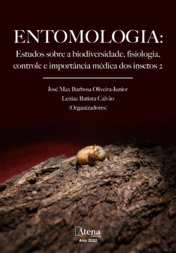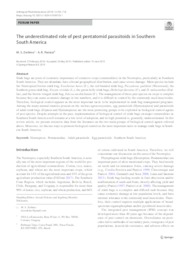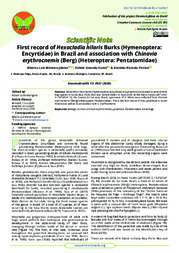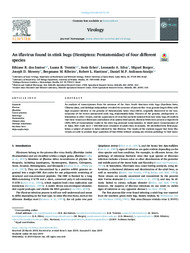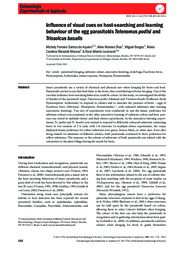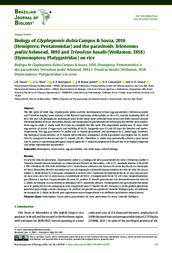Busca de Publicações
Filtrar por:
| Autoria: MINGOTI, R.; PESSOA, M. C. P. Y.; MORIYA, L. M.; PIZA, P. L. B. DE T.; MARINHO-PRADO, J. S.; DIOGO, M. DE S. Amblypelta nitida (Stal) (Hemiptera: Coreidae) é um inseto-praga polífago nativo da Austrália e pertencente ao grupo dos percevejos conhecidos por fruitspotting bugs (FSB). Entre os seus cultivos hosp... ... |
| Autoria: PANIZZI, A. R.; LUCINI, T. Phytophagous stink bugs (penatomidae) feed by inserting their sylets (mandibles + maxilae) in plan issues. |
| Autoria: DIAS, D. A.; FERNANDES, I. A.; MACHADO, E. P.; PEDOTT, L.; MORAES, M. C. B.; BORGES, M.; STEFFENS, J.; STEFFENS, C. Traditional pest management strategies, such as indiscriminate pesticide use, have adverse environmental and human health implications. As a sustainable alternative, this research focuses on employing... ... |
| Autoria: MARSARO JUNIOR, A. L.; STORCK-TONON, D.; HALINSKI, R.; MONTE, G. L. S.; GIL-SANTANA, H. R. Abstract. The predatory activities of Apiomerus duckei Costa Lima, Seabra & Hathaway, 1951, Apiomerus pilipes (Fabricius, 1787) and Apiomerus luctuosus Costa Lima, Seabra & Hathaway, 1951 (Hemiptera:... ... |
| Autoria: PESSOA, M. C. P. Y.; MINGOTI, R.; MORIYA, L. M.; PIVA, P. L. B.; DIOGO, M. de S. Amblypelta nitida (Stal) (Hemiptera: Coreidae), um fruitspotting bug (FSB) nativo da Austrália, ataca principalmente macadâmia, citros, abacate, pinha, lichia, maracujá, mamão e manga. Este inseto foi... ... |
| Autoria: ZERBINO, M. S.; PANIZZI, A. R. Stink bugs are pests of economic importance of extensive crops (commodities) in the Neotropics, particularly in Southern South America. They are abundant, have a broad geographical distribution, and c... ... |
| Autoria: MARSARO JUNIOR, A. L.; COSTA, V. A.; PANIZZI, A. R. Hexacladia hilaris Burks (Hymenoptera: Encyrtidae) is a parasitoid associated to several stink bug species in Costa Rica, Porto Rico and United States. In April 2018, at the Passo Fundo (28º15?46?S /... ... |
| Autoria: SANTOS, E. R. dos; TRENTIN, L. B.; ECKER, A.; SILVA, L. A.; BORGES, M.; MOWERY, J. D.; RIBEIRO, B. M.; HARRISON, R. L.; ARDISSON-ARAÚJO, D. M. P.
|
| Autoria: AQUINO, M. F. S. de; DIAS, A. M.; BORGES, M.; MORAES, M. C. B.; LAUMANN, R. A. Insect parasitoids use a variety of chemical and physical cues when foraging for hosts and food. Parasitoids can learn cues that lead themto the hosts, thus contributing to better foraging.One of the... ... |
| Autoria: SOUZA, J. R.; SILVA, C. G.; BARRIGOSSI, J. A. F.; MATOS JUNIOR, J. B.; CONCEIÇÃO, D. P.; SOUSA, G. O. he life cycle of stink bug, Glyphepomis dubia and the development of two egg parasitoids (Telenomus podisi and Trissolcus basalis) were studied at the Federal University of Maranhão, at 26 ± 2oC, rela... ... |
Observações
1 - Por padrão são exibidas publicações dos últimos 20 anos. Para encontrar publicações mais antigas, configure o filtro ano de publicação, colocando o ano a partir do qual você deseja encontrar publicações. O filtro está na coluna da esquerda na busca acima.
2 - Para ler algumas publicações da Embrapa (apenas as que estão em formato ePub), é necessário ter, no celular ou computador, um desses softwares gratuitos. Sistemas Android: Google Play Livros; IOS: iBooks; Windows e Linux: software Calibre.
Acesse outras publicações
Acesse a Base de Dados da Pesquisa Agropecuária (BDPA) para consultar o acervo completo das bibliotecas da Embrapa.

